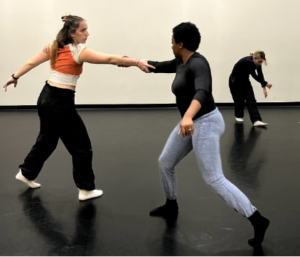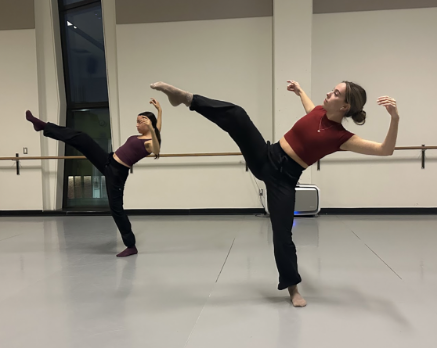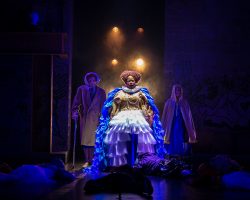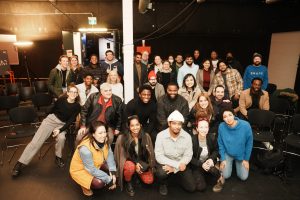Dance Innovations 2023: York University Unveils Infinite Corners, a Dazzling Showcase of Creative Resilience
Dance Innovations 2023: Infinite Corners, ran from Nov. 22 to 24 at the McLean Performance Studio and featured 25 new choreographic works by York University fourth-year Bachelor of Fine Arts students addressing various social issues and personal experiences.
Performed by students in all years of York’s undergraduate programs in dance, the series engaged with a range of human emotions. Each piece presented a unique concept, created in collaboration between the choreographer and the dancers. With the support of the faculty to turn their creativity into a full production, the student choreographers also collaborated with lighting designers, stage crew, and technicians.
The underlying motif throughout the show was an exploration of the spectrum of feelings that humans experience through the successes and hardships in life. It considered themes like climate change, feminism, emotional development, and gender theory.
“As we found ourselves in a time of recuperation following the pandemic, these creators asked: what did it mean to move forward then?” said Infinite Corners Artistic Director Tracey Norman. “How were we coming alive in our collaborative work differently? If infinite corners lead to circles and cycles, the goal of this production was to enliven the ideas, processes, and narratives that were important to this group of emerging artists.”
Presented in two series – Continuous and Unbounded – the show also featured a new work by Professor Susan Lee for the department’s third-year performance class.

One piece that addressed difficult emotions was “to move through” by Gabriella Noonan, examining the grieving process and how to grow throughout it. Dancers Megan Bagusoski, Isabella Castro, Autumn Ivan, Olivia Pereira, and Colleen Wiebe portrayed a depiction of grief after losing a loved one. As the dancers wove a narration of regret, nostalgia, and hope, they demonstrated the possibilities of moving forward after a heartbreaking event. “With those still here around us, we must find how we can move forward in a world that is missing a piece,” said Noonan.

Another piece that highlighted resilience in the face of hardship was Jemima Cummings’ “Perennial.” Using the metaphor of perennial flowers, Cummings’ work demonstrated the human ability to overcome obstacles. Noting how flowers always grew back after a long and cold winter, she used her choreography to suggest that people could also find joy after difficult moments. Performed by Isabella Castro, Alessia Di Palma, Autumn Ivan, Travis Keith, Eva Rodriguez Castro, and Olivia Williams, the work encouraged audiences to pursue happiness after challenging circumstances, rather than settle for mere survival. “Never stagnate in moments of utter desperation and sadness. Pick yourself back up and bloom towards the sun,” said Cummings.

“Undivulged” by Emma Tate brought light to the challenges experienced by women in a patriarchal society. One of her choreographic goals was to break the stigma around problems that women face, as she and the dancers exposed the less glamorous parts of being a woman. Performers Liz Cairns, Sabrina Doughty, Madelyn Moneypenny, Emily Morton, Sonya Singh, Grace Sokolow, and Tehillah James used their movement to support each other through the externalization of their hidden obstacles. Throughout the piece, Tate asked, “How do we move forward in a world that diminishes the female voice and body?”

“Artificially Authentic” by Christiano DiDomenico questioned how to find authenticity despite the influence of others. This solo work, performed alternately by Katherine Colley and Maya Erwin, engaged with the idea of personality and how one’s personality is affected or altered by the people around them. In the creation process, DiDomenico explored “social chameleon” tendencies, which he described as the habit of changing one’s outward personality based on the expectations of others. To highlight this research, as the soloists performed the work, they were surrounded by a 15-person ensemble. The presence of the supporting dancers set the stage for a display of self-discovery.

“Déjà Vécu” by Rosie Halpin also explored beliefs about human nature. In contrast to the other works, Halpin’s choreography used a mystical lens to approach the notion of already having lived through a situation. She directed her questioning of past events toward an exploration of life after death. This piece, danced by Regan Baird, Clara Chemtov, Kerry Halpin, Annie Spence, Hanna Thakore, and Andie Weir, examined the idea of reconnecting with previous iterations of oneself from an undetermined afterlife. In her process, Halpin mused, “Maybe we were all just warped versions of past selves, like a cracked mirror that distorts a reflection.”
Story originally published to yFile on November 10, 2023.


